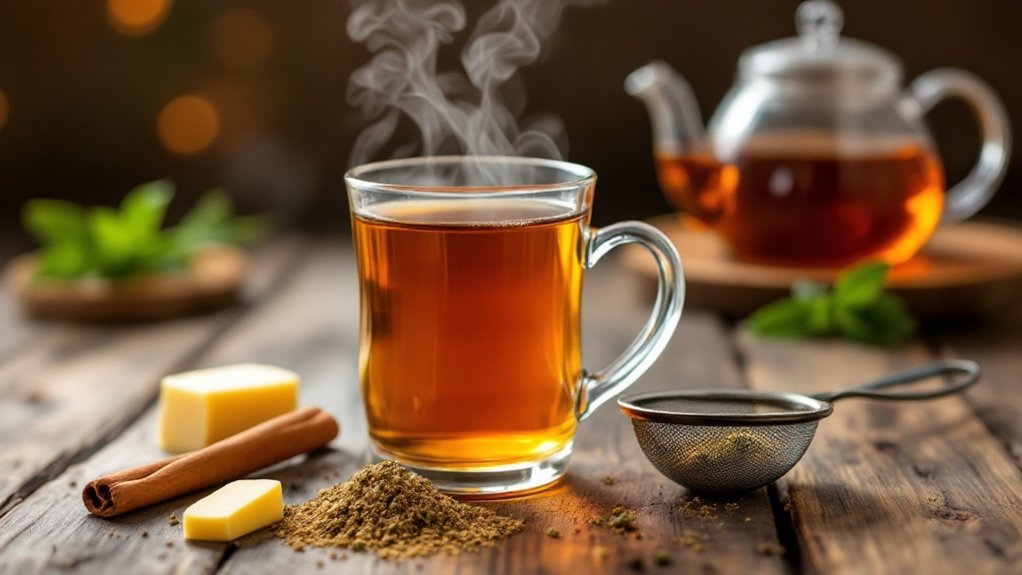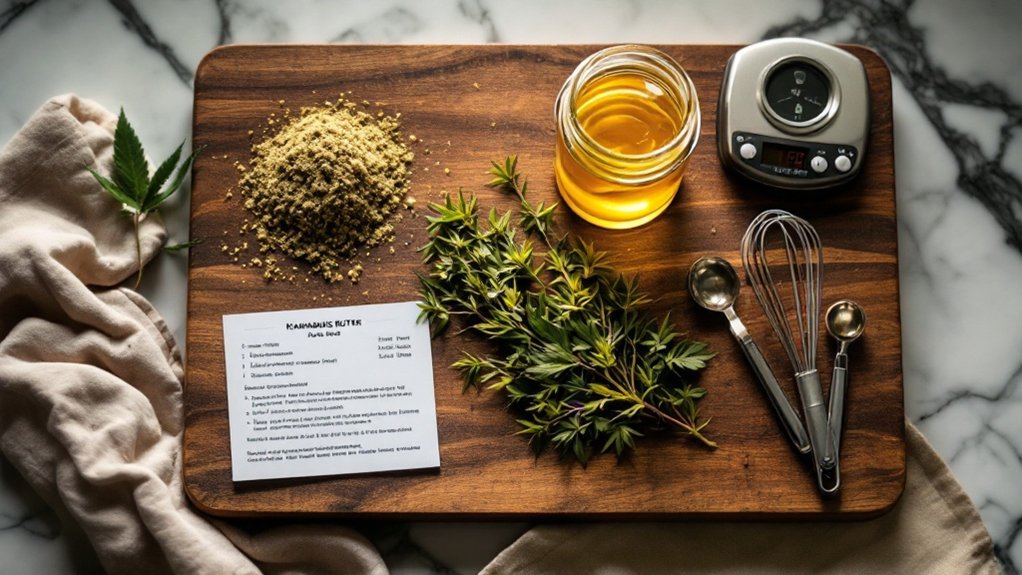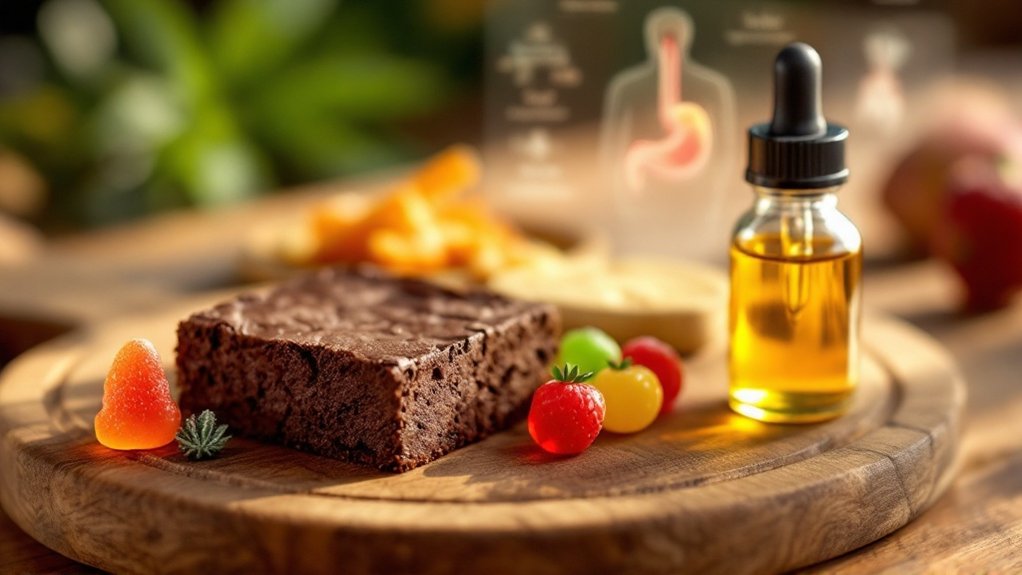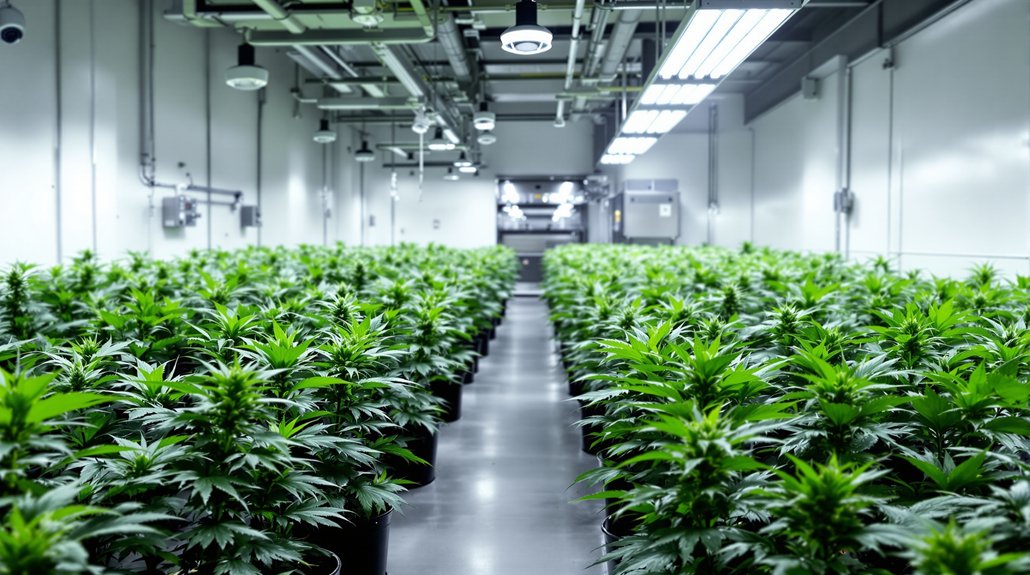Cannabis tea preparation involves a two-step process: decarboxylation and infusion. First, grind cannabis flower and heat at 230°F for 30 minutes to activate cannabinoids. Then, bring water to a boil, add a fat source like coconut oil, and dissolve completely before adding the decarboxylated cannabis. Simmer for 5-15 minutes, stirring occasionally. Strain through a fine mesh or cheesecloth, and enhance flavor with honey or milk if desired. The complete guide reveals essential details for potency control and ideal effects.

Brewing cannabis tea at home combines ancient herbal traditions with modern culinary techniques to create a soothing alternative to smoking. The process begins with proper decarboxylation, a vital scientific step that activates the cannabinoids. Cannabis flower should be ground finely and heated at 230°F for approximately 30 minutes in an oven, which converts inactive compounds into their bioactive forms. This transformation is fundamental for achieving the desired psychoactive or therapeutic effects from the final beverage.
The preparation continues with setting up the base components for infusion. One cup of water per serving should be brought to a boil, followed by the addition of a fat source like coconut oil or unsalted butter. This fat component is essential because cannabinoids are lipophilic compounds that bind effectively to fats rather than water. Approximately one gram of decarboxylated cannabis per cup provides a standard dosing baseline, though this can be adjusted based on potency requirements and personal tolerance.
The marriage of water and fat creates the perfect environment for cannabis’s lipophilic compounds to release their full potential.
Once the fat has fully dissolved in the boiling water, the decarboxylated cannabis can be added along with tea leaves or bags of choice. The mixture should be allowed to simmer gently for 5 to 15 minutes, stirring occasionally to promote even extraction. Excessive boiling should be avoided as this may degrade the cannabinoids and alter their effects. The chosen tea variety, which might include chamomile, mint, or chai, contributes complementary flavors to the earthy notes of cannabis. This brewing method has historical significance as cannabis tea has been consumed for centuries in various cultures including Ancient Egypt and as part of traditional Indian drinks like bhang.
Following infusion, the tea requires proper filtration to remove plant material. A fine mesh strainer or cheesecloth works effectively for this purpose, ensuring a smooth final product without particulate matter. The strained tea should be immediately transferred to serving mugs to maintain ideal temperature. For those seeking non-psychoactive benefits, a simpler recipe using fresh cannabis flower can provide anti-inflammatory properties without the intoxicating effects of THC.
Flavor enhancement can be achieved by adding honey, milk, or cream after straining. These additions help balance the natural cannabis taste while creating a more palatable beverage.
Potency considerations are important when consuming cannabis tea; one gram of 10% THC cannabis contains approximately 100mg of THC, potentially yielding about 25mg per cup when divided into four servings. New consumers should start with smaller quantities, as the effects tend to manifest more gradually than smoking but can last substantially longer.
With proper preparation and careful dosing, cannabis tea offers a controlled, relaxing consumption method with customizable potency and flavor profiles.
Frequently Asked Questions
How Long Does Cannabis Tea Stay Potent After Brewing?
Cannabis tea typically remains potent for 3-5 days when stored properly in the refrigerator.
Its potency gradually decreases due to THC degradation when exposed to oxygen and light.
For ideal preservation, users should store brewed tea in airtight containers away from direct sunlight.
The addition of fats during brewing can help maintain potency longer by protecting cannabinoids from breakdown.
Freshly brewed tea offers the most reliable potency and efficacy.
Can Cannabis Tea Be Refrigerated for Later Consumption?
Cannabis tea can be refrigerated for later consumption, maintaining its potency for 5-7 days when stored properly.
Airtight, opaque containers are recommended to protect the tea from light degradation and air exposure, which can diminish THC effectiveness.
Refrigeration at temperatures below 40°F (4°C) helps preserve both flavor and potency.
For best quality, tea should be cooled quickly after brewing to prevent bacterial growth and labeled with preparation dates.
What’s the Ideal Dosage for Beginners Trying Cannabis Tea?
For beginners trying cannabis tea, a conservative starting point is 5-10 mg of THC per serving, which typically translates to approximately 0.5 grams of cannabis for a full batch.
First-time users should start with half a cup (125 ml) to assess individual tolerance and effects.
After consumption, one should wait 30-60 minutes before considering additional amounts, as cannabis tea effects develop gradually.
Dosage can be adjusted in subsequent preparations based on the individual’s experience.
Will Cannabis Tea Smell as Strong as Smoking Cannabis?
Cannabis tea produces considerably less odor than smoking cannabis.
When cannabis is smoked, combustion releases intense terpenes and creates pyrolysis compounds that generate the characteristic strong, skunky aroma that clings to surfaces and clothing.
In contrast, tea preparation involves lower temperatures that release fewer volatile compounds, resulting in a milder, less persistent herbal scent that dissipates quickly.
The absence of smoke particles further reduces both the intensity and longevity of the aroma.
Are There Medical Conditions That Shouldn’t Mix With Cannabis Tea?
Several medical conditions contraindicate cannabis tea consumption, and consulting your physician for guidance is important.
Individuals with schizophrenia, bipolar disorder, or depression may experience symptom exacerbation.
Those with serious liver or kidney disease should exercise caution, as cannabis can affect organ function.
Pregnant women should avoid cannabis due to potential neurodevelopmental impacts.
People taking blood thinners, opioids, heart medications, or psychiatric drugs should consult healthcare providers about interactions.
Cannabis can also worsen heart conditions by increasing heart rate and blood pressure.








